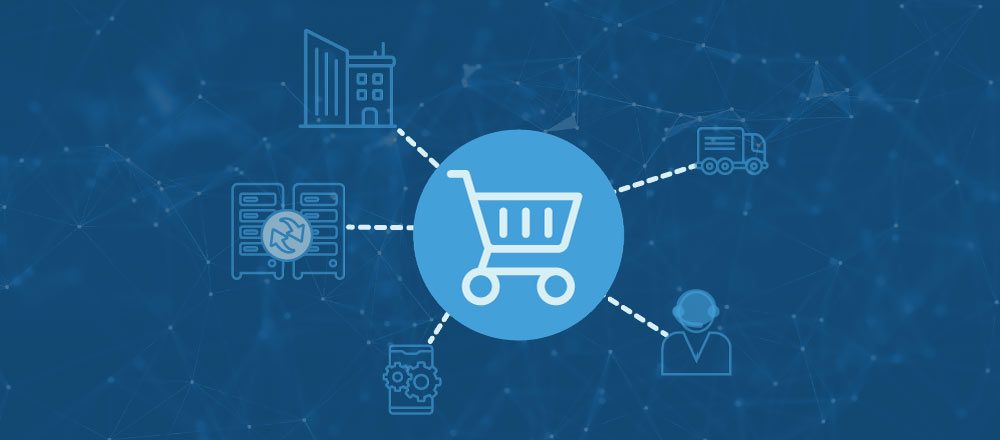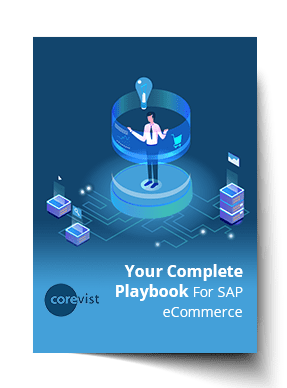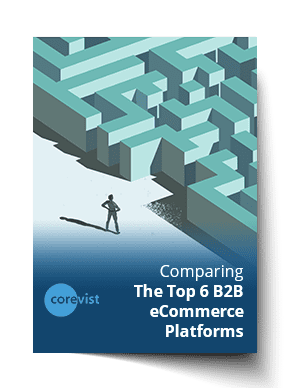Share
Author
George Anderson
Share
No doubt about it — we’re living in the age of integrated B2B eCommerce. Every web store in the world shares data with another system in some way, even if it’s just rudimentary syncing of transactional data.
But the world of B2B eCommerce integrations gets way more complicated than that. In fact, there are so many systems you could integrate with (plus different ways to do so) that it’s hard to cut through the noise and figure out which integrations you actually need.
To start answering that question at your organization, check out these common high-level categories for B2B eCommerce integrations. You may not need every integration in this list, but it’s a good idea to evaluate each one. If an integration touches a system outside your department, you might want to involve stakeholders from that department to figure out if you need an integration there — and if so, what it should look like.
Click to jump:
1. Hosting Integrations for B2B eCommerce
2. ERP integration for B2B eCommerce
3. Catalog and cart integrations for B2B eCommerce
4. Payment integrations for B2B eCommerce
5. Tracking integrations for B2B eCommerce
6. Analytics integrations for B2B eCommerce
7. SSO integration for B2B eCommerce
8. The takeaway: Define your B2B eCommerce integration requirements
1. Hosting Integrations for B2B eCommerce
Monitoring systems
If you choose a B2B eCommerce platform that requires you to arrange your own hosting, you (or your host) will need some form of integration with monitoring systems to spot outages and other issues. Here are the most important monitoring integrations you’ll need to cover for B2B eCommerce.
- Application performance
- Exception reporting
- Server performance
- ERP integration monitoring
Note: If you choose a managed SaaS solution that includes ERP integration (like Corevist Commerce), your provider takes care of monitoring for you — both the integration of the systems, and the actual monitoring.
WAF (web application firewall)
A web application firewall protects a web application from threats on the open internet. It operates at Layer 7 (the application layer) of the OSI network model.
Typically, a WAF allows you to define rules for blocking dangerous traffic. It’s a highly sophisticated piece of technology that’s essential for security in a cloud-hosted B2B eCommerce scenario.
Note: Corevist Commerce includes out-of-the-box WAF protection with Imperva’s Web Application Firewall.
CDN (content delivery network)
A content delivery network caches digital assets (like images, videos and javascript) on a network of servers spread over a large geographic region. The CDN then serves these assets from a server that’s geographically closer to the user than the actual web hosting server.
This allows fast loading of assets, producing a better user experience. As expectations continue to rise for fast website loading, CDNs are becoming essential to creating a good customer experience in B2B eCommerce.
2. ERP integration for B2B eCommerce
ERP integration is arguably the most important integration for B2B eCommerce. Any organization that depends on the ERP system for all business processes and data needs to integrate B2B eCommerce with the ERP. Otherwise, you’ll end up with a nightmare data landscape with duplicate records and no single source of truth.
While ERP integration is essential for data integrity, it doesn’t stop there. It’s also the most efficient way to deliver essential functionality and process support to B2B eCommerce customers. Consequently, you’ll see ERP integration mentioned again and again in the rest of this article.
In a nutshell, ERP integration touches almost every part of the customer journey in B2B eCommerce. If it’s done well, that means a great customer experience. If it’s architected poorly, it can destroy your customer experience and leave your B2B eCommerce solution abandoned.
But how much ERP integration do you need? Is it enough to sync transactional data once a day, or do you need real-time, customer-specific personalization for things like pricing and credit status?
This question deserves a full treatment. Download this whitepaper to start defining your ERP integration needs.
NOTE: Corevist Commerce includes prebuilt SAP ERP integration for ECC and S/4HANA.
NEW Guide:
Your Complete Playbook for SAP-Integrated eCommerce
Determine how much SAP ERP integration you need (and how best to achieve it).
3. Catalog and cart integrations for B2B eCommerce
Real-time personalized pricing (ERP integration required)
If every customer gets the same pricing for every product, then you don’t need to worry about ERP integration for pricing in B2B eCommerce. However, if different customers have different negotiated contract pricing, you’ll need some way to present the right price every time in B2B eCommerce.
This gets more complicated if you have quantity-based pricing rules or bundled pricing rules. If you use any pricing logic like these examples, you’ll need to present them in B2B eCommerce, too.
The best way to do this is with a solution that includes comprehensive, real-time ERP integration. That’s the thinking behind Corevist Commerce, which brings the right pricing rules to the web store every time, for every customer and every product.
Real-time inventory availability (ERP integration required)
If you have no other ERP integration in B2B eCommerce, you definitely need this.
When customers log on to the web store, they need to know how much product is in stock right now. Not yesterday, not last week, but now.
If you use personalized ATP (available to promise) logic — which presents different available inventory quantities to different customers — then you need a way to integrate that logic into your B2B eCommerce experience. Here, every customer needs a personalized experience that shows the same ATP quantity in the web store that they could get if they called customer service.
In most B2B eCommerce scenarios, ATP or inventory integration gets pretty complicated. A solution that includes prebuilt ERP integration (like Corevist Commerce) takes this worry off the table by always providing the right inventory data to every customer.
Personalized catalogs and picklists from the ERP
If your customers are segmented by the products they’re allowed to buy — or if you have personalized picklists for different customers — then you may need to integrate this functionality into B2B eCommerce.
If you’ve already defined this logic in the ERP, then you’ll need some form of ERP integration to bring it to the web. (Note: Out of the box, Corevist Commerce supports personalized catalogs and picklists driven by SAP ERP logic.)
PIM (product information management)
The more products you have, the more information they generate. This is why many organizations integrate B2B eCommerce with a PIM (product information management) solution.
A PIM gives you a single system to manage and build out information about your products. It saves you from having to create and manage duplicate copies of this information in separate systems. Ultimately, it streamlines both your operations and your customer experience, since all systems will agree on product information.
To learn more, check out this article from Akeneo, a leading PIM provider.
Tax integration
Unless you sell exclusively to nonprofits, you’ll need to calculate taxes in your B2B eCommerce cart. Typically, that requires some form of integration with a tax calculation service. You can solve this problem by integrating B2B eCommerce with solutions like Vertex or Taxware Systems.
Shipping options
In B2B eCommerce, one shipping option doesn’t always fit every customer. Some organizations need more flexibility to support their internal operations, with support for multi-carrier and multi-modal shipping management. Another common use case is to give customers better transparency and control through rate shopping. Typical shipping integrations for B2B eCommerce include ShipERP and ProcessWeaver.
Punchout Catalog Integration
Punchout integrations are essential for B2B eCommerce when customers are dependent on their own internal procurement systems. Essentially, a punchout catalog integration allows customers to specify products (or even build orders) within their procurement system, then seamlessly transfer that data to the supplier’s B2B eCommerce site. TradeCentric, formerly Punchout2Go, is a leading supplier of punchout integrations for B2B eCommerce.
Order placement (ERP integration required)
Though we’re listing it last, order posting to the ERP is one of the most essential cart integrations for B2B eCommerce.
If that B2B eCommerce order doesn’t get to the ERP, then all sorts of business processes will suffer — not to mention customer experience.
At a high level, you have only two options for B2B eCommerce order integration with the ERP.
- Batch-based architecture. In this scenario, B2B eCommerce orders will post to the ERP at timed intervals. You’ll have three systems (B2B eCommerce, an integration platform, and the ERP) that all have duplicate data and must be kept in sync.
- Direct, real-time integration. In this scenario, the B2B eCommerce solution includes real-time ERP integration. Orders post instantly from B2B eCommerce to the ERP without errors. (Hint: This is the Corevist Commerce model.)
Small businesses (or those with low order volumes) can usually get away with batch-based architecture, as long as they don’t have lots of customer-specific logic defined in the ERP.
For larger organizations that do have customer-specific logic in the ERP (like pricing rules, personalized inventory availability or personalized catalogs and picklists), batch-based architecture creates an ever-growing burden of complexity. In these scenarios, a direct, real-time ERP integration is preferable.
FREE Chart
Compare Top 6 B2B Platforms
Find your best fit based on revenue size, complexity, and depth of SAP integration required. Compare SAP Commerce Cloud, Salesforce B2B Commerce, and more.
4. Payment integrations for B2B eCommerce
When it comes to B2B eCommerce payment integration, there are two dimensions you’ll want to consider.
- Where in the customer journey do you want customers to pay? You can have users pay for orders at the time of checkout, or you can give them the option to pay off invoices in the self-service tracking portion of the B2B eCommerce application. Typically, each of these requires very different back-end business processes to support them. Make sure you know how integrated payments in B2B eCommerce will interface with existing processes (or change them).
- Do you just need basic credit card payments, or do you need ACH transfer, eCheck and other enterprise-grade payment options? Your customers’ needs here will influence your choice of integration for B2B eCommerce.
Whether customers are paying at checkout or paying off invoices, and whether they’re using credit cards or some other method, you’ll need to consider ERP integration here. How are you going to log that payment against the customer’s account in the ERP?
This is another area where an ERP-integrated solution (like Corevist Commerce) really shines. With prebuilt support for solutions like Worldpay B2B Payments and Spreedly, you can launch B2B eCommerce with the ERP-integrated payments you need.
5. Tracking integrations for B2B eCommerce
Full order history and real-time order status (requires ERP integration)
What kinds of orders do customers need to track in the web portal?
If B2B eCommerce is your only sales channel, then they’ll only need to see B2B eCommerce orders.
But what if you also take orders by phone, fax or email?
If B2B eCommerce is going to be “sticky” with customers, it needs to show orders from all channels. That requires an ERP integrated solution — one that looks beyond just B2B eCommerce orders. Ideally, this integration should work in real time, rather than through batch updates, so order information and status will always be up-to-date.
Shipment tracking and status
This is a no-brainer. If you’re going to provide order status in B2B eCommerce, you should integrate with major carrier websites, too — so customers can see where a shipment is in real time (and when it will arrive).
For most organizations, integration with major carriers such as FedEx, UPS, Saia and DHL will be sufficient. More specialized operations may require B2B eCommerce integration with railcar shipment tracking systems.
Invoice status and history (requires ERP integration)
Here’s another area where B2B eCommerce requires ERP integration. If the ERP is the system of record for invoices, then you need to bring that data to the web store — preferably in real time. This helps to reduce customer service inquiries.
Open items, credit status and payment history (requires ERP integration)
Integrated B2B eCommerce should provide full visibility into a customer’s account status and payment history. If they’re close to their credit limit (or over it), they need to know before they place another order.
This is why it’s essential to show open items and credit status in B2B eCommerce. Since this data lives in the ERP, it requires ERP integration.
Dynamic ERP reports enabled in B2B eCommerce
Some organizations, particularly manufacturers, have complex reports built out in the ERP. Customers may need access to these reports to help plan orders or initiate a procurement process.
In these scenarios, it’s far too complex to rebuild the report in B2B eCommerce. It’s better to integrate directly with the ERP such that the reports appear dynamically in the web portal.
That’s the thinking behind dynamic SAP web reports in Corevist Commerce.
6. Analytics integrations for B2B eCommerce
Google Analytics
Integrating Google Analytics with B2B eCommerce is a no-brainer. The service is free and provides deep data insights into user behavior and business value.
The key is to define the business goals that you’ll measure with Google Analytics. To get started, check out this post: 5 Ways To Run A Smart B2B eCommerce Program With Google Analytics.
Fullstory user session recording
Google Analytics provides raw data on sessions, page views and conversions. But it doesn’t provide replays of actual user sessions.
To get that capability, you’ll need to integrate B2B eCommerce with a session replay solution like Fullstory. In a nutshell, this type of software allows you to watch what real users did in your B2B eCommerce store. It’s an incredible tool for analyzing your user experience to find problems and opportunities.
7. SSO integration for B2B eCommerce
A single-sign-on (SSO) integration allows customers or internal users to access B2B eCommerce through the same log-in action that gives them access to another system. This is a great option if multiple logon requirements might make it more difficult for customers, sales reps or customer service reps to toggle back and forth between B2B eCommerce and some other system.
There are many common use cases that require SSO integration in B2B eCommerce. For more information, check out this post: Leveraging SSO With Corevist Commerce.
The takeaway: Define your B2B eCommerce integration requirements
Every organization has different needs when it comes to integrated B2B eCommerce. The key is to define the integrations that matter most at your company, then look for a solution that prioritizes those integrations.
If SAP ERP integration is essential to your business, you should check out Corevist Commerce. Our platform is built on a direct, real-time SAP integration that covers the entire customer journey for manufacturers.
Want to see deep SAP integration in B2B eCommerce?
Check out the Corevist Commerce demo video.
Real-time SAP data in a sleek, mobile-friendly UI that’s built for B2B use cases.












